Research Progress of Single-Mode Quantum Cascade Lasers
Abstract
1. Introduction
2. Technological Evolution and Challenges of Single-Mode Quantum Cascade Lasers
2.1. Rigid Demand for the Performance of High-Quality Single-Mode QCLs
2.2. Unsolved Core Technical Bottlenecks
3. Advances in Research on DBR-QCL
3.1. Chapter Introduction
3.2. Reflector Design and Process Breakthroughs
3.2.1. Low-Loss/Low-Power Design
3.2.2. Hybrid Structures and Process Tolerances
3.3. Wavelength Tuning and High-Temperature Stability
3.3.1. Wide Tuning and Precise Control
3.3.2. Breakthrough in High-Temperature Performance
3.4. Beam Control and Mode Optimization
3.4.1. Single-Petal Surface Emission
3.4.2. Long-Range Single-Mode Control
3.5. System Integration and Application Expansion
3.5.1. Exploration of New Architectures
3.5.2. Multi-Scenario Applications
3.6. Challenges and Future Directions
4. Advances in Distributed Feedback (DFB) Single-Mode Quantum Cascade Lasers
4.1. Overview
4.2. Grating Structure Innovations and Single-Mode Control Mechanisms
4.2.1. Sampling Grating Technology
4.2.2. Surface Emission Structures
4.2.3. Annular Cavity Single-Mode Control
4.3. Single-Mode Stability Enhancement Techniques
4.3.1. Anti-Mode Jump Design
4.3.2. Stability Under Extreme Conditions
4.3.3. Narrow Line Width Assurance
4.4. Advanced Manufacturing Process
4.4.1. Breakthroughs in Wafer-Level Mass Production
4.4.2. Machine Learning-Assisted Design
4.5. Application of Single-Mode System Integration
4.5.1. Multi-Wavelength Single-Mode Integration
4.5.2. Single-Mode Array and Beam Control
4.5.3. Emerging Application Scenarios
4.6. Summaries and Challenges
5. Summary and Outlook
5.1. Technological Paradigm Shifts
5.2. Reconfiguration of Application Scenarios
Author Contributions
Funding
Data Availability Statement
Conflicts of Interest
References
- Faist, J.; Capasso, F.; Sivco, D.L.; Sirtori, C.; Hutchinson, A.L.; Cho, A.Y. Quantum cascade laser. Science 1994, 264, 553–556. [Google Scholar] [CrossRef] [PubMed]
- Lu, Q.Y.; Bai, Y.; Bandyopadhyay, N.; Slivken, S.; Razeghi, M. Room-temperature continuous wave operation of distributed feedback quantum cascade lasers with watt-level power output. Appl. Phys. Lett. 2010, 97, 231119. [Google Scholar] [CrossRef]
- Lu, Q.Y.; Bai, Y.; Bandyopadhyay, N.; Slivken, S.; Razeghi, M. 2.4 W room temperature continuous wave operation of distributed feedback quantum cascade lasers. Appl. Phys. Lett. 2011, 98, 181106. [Google Scholar] [CrossRef]
- Diba, A.S.; Xie, F.; Gross, B.; Lu, W.; Caneau, C.; Visovsky, N.J.; Phillips, M.C.; Gluszek, A.; Hudzikowski, A.; Weidmann, D. Application of a broadly tunable SG-DBR QCL for multi-species trace gas spectroscopy. Opt. Express 2015, 23, 27123–27133. [Google Scholar] [CrossRef]
- Bertrand, M.; Shlykov, A.; Shahmohamadi, M.; Beck, M.; Willitsch, S.; Faist, J. High-power, narrow-linewidth distributed-feedback quantum-cascade laser for molecular spectroscopy. Photonics 2022, 9, 589. [Google Scholar] [CrossRef]
- Bismuto, A.; Blaser, S.; Terazzi, R.; Gresch, T.; Muller, A. High performance, low dissipation quantum cascade lasers across the mid-IR range. Opt. Express 2015, 23, 5477–5484. [Google Scholar] [CrossRef]
- Slivken, S.; Bandyopadhyay, N.; Tsao, S.; Nida, S.; Bai, Y.; Lu, Q.Y.; Razeghi, M. Sampled grating, distributed feedback quantum cascade lasers with broad tunability and continuous operation at room temperature. Appl. Phys. Lett. 2012, 100, 261112. [Google Scholar] [CrossRef]
- Slivken, S.; Bandyopadhyay, N.; Bai, Y.; Razeghi, M. Extended electrical tuning of quantum cascade lasers with digital concatenated gratings. Appl. Phys. Lett. 2013, 103, 231110. [Google Scholar] [CrossRef]
- Mansuripur, T.S.; Menzel, S.; Blanchard, R.; Pflügl, C.; Diehl, L.; Edamura, T.; Yamanishi, M.; Capasso, F. Widely tunable mid-infrared quantum cascade lasers using sampled grating reflectors. Opt. Express 2012, 20, 23339–23348. [Google Scholar] [CrossRef]
- Yoshinaga, H.; Kato, T.; Mori, H.; Sato, M.; Saito, T. High-Temperature (200 °C) Operation of 7.4 μm Distributed Feedback (DFB) Quantum Cascade Laser. In Proceedings of the 2018 IEEE International Semiconductor Laser Conference (ISLC), Santa Fe, NM, USA, 16–19 September 2018; pp. 1–2. [Google Scholar] [CrossRef]
- Bai, H.; Zang, S.; Tan, C.; Wang, K.; Gan, L.; Xu, G. Single mode terahertz quantum cascade laser based on Bragg reflector. J. Infrared Millim. Waves 2023, 42, 795–805. [Google Scholar] [CrossRef]
- Olariu, T.; Beck, M.; Faist, J. Post-process frequency tuning of single-mode quantum cascade laser at 4.7 THz. IEEE J. Quantum Electron. 2023, 59, 1–7. [Google Scholar] [CrossRef]
- Yao, D.Y.; Zhang, J.C.; Cathabard, O.; Zhuo, N.; Liu, J.Q.; Liu, F.Q.; Wang, Z.G. 10-W pulsed operation of substrate emitting photonic-crystal quantum cascade laser with very small divergence. Nanoscale Res. Lett. 2015, 10, 177. [Google Scholar] [CrossRef][Green Version]
- Li, J.S.; Chen, W.; Fischer, H. Quantum cascade laser spectrometry techniques: A new trend in atmospheric chemistry. Appl. Spectrosc. Rev. 2013, 48, 523–559. [Google Scholar] [CrossRef]
- Pinto, D.; Díaz Thomas, D.A.; Loghmari, Z.; Gellie, P.; Lampin, J.F.; Sagnes, I.; Beaudoin, G.; Fill, M.; Amanti, M.I.; Sirtori, C. Long wavelength distributed feedback tapered quantum cascade lasers. Opt. Express 2024, 32, 26925–26937. [Google Scholar] [CrossRef] [PubMed]
- Guan, Y.; Lu, X.; Cheng, F.; Zhang, J.; Zhuo, N.; Liu, F.; Wang, Z. Continuous-wave distributed Bragg reflector quantum cascade lasers with fine single-mode tuning up to 102 °C at λ~8.4 µm. Opt. Commun. 2024, 528, 128994. [Google Scholar] [CrossRef]
- Ge, L.; Yang, N.; Wang, J.; Liu, J.; Liu, F. Self-Mixing Signal Characteristics of Complex-Coupled Distributed-Feedback Terahertz Quantum-Cascade Lasers. Front. Phys. 2021, 9, 744286. [Google Scholar] [CrossRef]
- Ohtani, K.; Turčinková, D.; Bonzon, C.; Beck, M.; Faist, J. High performance 4.7 THz GaAs quantum cascade lasers based on four quantum wells. New J. Phys. 2016, 18, 123004. [Google Scholar] [CrossRef]
- Radosavljevic, S.; Radosavljević, A.; Schilling, C.; Hugger, S.; Ostendorf, R.; Kuyken, B.; Roelkens, G. Thermally tunable quantum cascade laser with an external germanium-on-SOI distributed Bragg reflector. IEEE J. Sel. Top. Quantum Electron. 2019, 25, 1–7. [Google Scholar] [CrossRef]
- Hinkov, B.; Bismuto, A.; Bonetti, Y.; Beck, M.; Faist, J. Singlemode quantum cascade lasers with power dissipation below 1 W. Electron. Lett. 2012, 48, 646–647. [Google Scholar] [CrossRef]
- Chassagneux, Y.; Wang, Q.J.; Khanna, S.P.; Linfield, E.H.; Davies, A.G.; Beere, H.E.; Ritchie, D.A. Limiting factors to the temperature performance of THz quantum cascade lasers based on the resonant-phonon depopulation scheme. IEEE Trans. Terahertz Sci. Technol. 2011, 2, 83–92. [Google Scholar] [CrossRef]
- Jia, Z.W.; Wang, L.J.; Zhang, J.C.; Liu, F.Q.; Wang, Z.G. High efficiency, low power-consumption DFB quantum cascade lasers without lateral regrowth. Nanoscale Res. Lett. 2017, 12, 281. [Google Scholar] [CrossRef]
- Guan, Y.; Sun, R.; Zhuo, N.; Lu, X.; Zhang, J.; Zhai, S.; Liu, F. Room temperature continuous-wave operation of a dual-wavelength quantum cascade laser. Chin. Opt. Lett. 2023, 21, 011408. [Google Scholar] [CrossRef]
- Guan, Y.; Wang, L.; Zhuo, N.; Zhang, J.; Zhai, S.; Liu, J.; Liu, F. Dual-wavelength switchable, mid-infrared quantum cascade laser with two shallow-etched distributed Bragg reflectors. Opt. Express 2021, 29, 39376–39383. [Google Scholar] [CrossRef]
- Zhang, J.C.; Liu, F.Q.; Tan, S.; Wang, L.J.; Li, L.; Liu, J.Q.; Wang, Z.G. High-performance uncooled distributed-feedback quantum cascade laser without lateral regrowth. Appl. Phys. Lett. 2012, 100, 111103. [Google Scholar] [CrossRef]
- Babichev, A.; Kolodeznyi, E.; Gladyshev, A.; Kharin, N.; Panevin, V.; Shalygin, V.; Voznyuk, G.; Mitrofanov, M.; Slipchenko, S.; Lyutetskii, A.; et al. Single-mode lasing in ring-cavity surface-emitting lasers. J. Opt. Technol. 2023, 90, 422–427. [Google Scholar] [CrossRef]
- Ryu, J.H.; Sigler, C.; Boyle, C.; Kirch, J.D.; Lindberg, D.; Earles, T.; Mawst, L.J. Surface-emitting quantum cascade lasers with 2nd-order metal/semiconductor gratings for high continuous-wave performance. Proc. SPIE 2020, 11301, 189–199. [Google Scholar] [CrossRef]
- Coutard, J.G.; Brun, M.; Fournier, M.; Lartigue, O.; Fedeli, F.; Maisons, G.; Duraffourg, L. Volume Fabrication of Quantum Cascade Lasers on 200 mm-CMOS pilot line. Sci. Rep. 2020, 10, 6185. [Google Scholar] [CrossRef]
- Tang, P.; Chi, X.; Chen, B.; Wu, C. Predictions of resonant mode characteristics for terahertz quantum cascade lasers with distributed feedback utilizing machine learning. Opt. Express 2021, 29, 15309–15326. [Google Scholar] [CrossRef] [PubMed]
- Ye, F.; Cheng, F.; Jia, Z.; Zhang, J.; Zhuo, N.; Liu, F.; Shi, Y. Stable single-mode 20-channel uniform buried grating DFB QCL array emitting at ~8.3 μm. Opt. Quantum Electron. 2022, 54, 236. [Google Scholar] [CrossRef]
- Zhang, J.C.; Liu, F.Q.; Yao, D.Y.; Wang, L.J.; Liu, J.Q.; Wang, Z.G. Multi-wavelength surface emitting quantum cascade laser based on equivalent phase shift. J. Appl. Phys. 2014, 115, 033102. [Google Scholar] [CrossRef]
- Babichev, A.V.; Pashnev, D.A.; Gladyshev, A.G.; Denisov, D.V.; Voznyuk, G.V.E.; Karachinsky, L.Y.; Egorov, A.Y. Quantum-cascade lasers with a distributed Bragg reflector formed by ion-beam etching. Tech. Phys. Lett. 2020, 46, 312–315. [Google Scholar] [CrossRef]
- Ryu, J.H.; Sigler, C.; Kirch, J.D.; Earles, T.; Botez, D.; Mawst, L.J. Fabrication-tolerant design for high-power, single-lobe, surface-emitting quantum cascade lasers. IEEE Photonics Technol. Lett. 2021, 33, 820–823. [Google Scholar] [CrossRef]
- Chen, J.; Gao, L.; Jin, Y.; Reno, J.L.; Kumar, S. High-intensity and low-divergence THz laser with 1D autofocusing symmetric Airy beams. Opt. Express 2019, 27, 22877–22889. [Google Scholar] [CrossRef] [PubMed]
- Turville-Heitz, M.; Marsland, R.; Ryu, J.H.; Jacobs, S.A.; Kirch, J.D.; Earles, T.; Mawst, L.J. λ~4.7 µm Quantum Cascade Distributed-Feedback Lasers for Free-Space. Photonics 2025, 12, 51. [Google Scholar] [CrossRef]
- Bismuto, A.; Bidaux, Y.; Blaser, S.; Terazzi, R.; Gresch, T.; Rochat, M.; Muller, A.; Bonzon, C.; Faist, J. High power and single mode quantum cascade lasers. Opt. Express 2016, 24, 10694–10699. [Google Scholar] [CrossRef]
- Guan, Y.J.; Jia, X.F.; Li, S.S.; Wang, L.J.; Zhuo, N.; Zhang, J.C.; Wang, Z.G. High power tapered sampling grating distributed feedback quantum cascade lasers. IEEE Photonics Technol. Lett. 2020, 32, 305–308. [Google Scholar] [CrossRef]
- Chen, J.; Jin, Y.; Gao, L.; Reno, J.L.; Kumar, S. Wavelength beam-combining of terahertz quantum-cascade laser arrays. Opt. Lett. 2021, 46, 1864–1867. [Google Scholar] [CrossRef]
- Cheng, F.; Zhang, J.; Sun, Y.; Zhuo, N.; Zhai, S.; Liu, J.; Liu, F. High performance distributed feedback quantum cascade laser emitting at λ~6.12 um. Opt. Express 2022, 30, 5848–5854. [Google Scholar] [CrossRef] [PubMed]
- Yoshinaga, H.; Hashimoto, J.I.; Mori, H.; Tsuji, Y.; Murata, M.; Ekawa, M.; Katsuyama, T. Mid-infrared quantum cascade laser integrated with distributed Bragg reflector. Proc. SPIE 2016, 9755, 280–285. [Google Scholar] [CrossRef]
- Janczak, M.; Sarzała, R.P.; Dems, M.; Kolek, A.; Bugajski, M.; Nakwaski, W.; Czyszanowski, T. Threshold performance of pulse-operating quantum-cascade vertical-cavity surface-emitting lasers. Opt. Express 2022, 30, 45054–45069. [Google Scholar] [CrossRef]
- Cristobal, E.; Shu, H.; Lyakh, A. Substrate-emitting quantum cascade lasers with a distributed Bragg reflector and a spectrally detuned second-order outcoupler. AIP Adv. 2021, 11, 115302. [Google Scholar] [CrossRef]
- Wang, K.; Bai, H.; Yu, C.; Zhu, H.; Chen, P.; Lu, W.; Li, L.; Davies, A.G.; Linfield, E.H.; Li, H.; et al. Independent control of mode selection and power extraction in terahertz semiconductor lasers. ACS Photonics 2022, 9, 1973–1983. [Google Scholar] [CrossRef]
- Shu, H.; Suttinger, M.; Lyakh, A. Floquet-Bloch analysis for distributed feedback quantum cascade lasers with a non-rectangular top-metal grating profile. IEEE J. Quantum Electron. 2019, 55, 1–7. [Google Scholar] [CrossRef]
- Li, W.; Ma, Y.; Xu, Y.; Liu, J.; Wang, L.; Zhuo, N.; Lu, Q.; Zhang, J.; Zhai, S.; Liu, S.; et al. Continuous-wave single-mode quantum cascade laser at 5.1 THz based on graded sampled grating design. Photonics Res. 2022, 10, 2686–2692. [Google Scholar] [CrossRef]
- Ye, F.; Cheng, F.; Jia, Z.; Zhang, J.; Zhuo, N.; Liu, F.; Shi, Y. Stable single-mode operation of distributed feedback quantum cascade laser under high current via a grating reflector. Nanophotonics 2023, 12, 1903–1912. [Google Scholar] [CrossRef]
- Xu, Y.; Li, W.; Ma, Y.; Lu, Q.; Zhang, J.; Zhai, S.; Liu, F. Phase-locked single-mode terahertz quantum cascade lasers array. J. Semicond. 2024, 45, 062401. [Google Scholar] [CrossRef]
- Zhao, F.; Li, Y.; Liu, J.; Liu, F.; Zhang, J.; Zhuo, N.; Wang, L.; Liu, S.; Wang, Z. Sampled grating terahertz quantum cascade lasers. Appl. Phys. Lett. 2019, 114, 141105. [Google Scholar] [CrossRef]
- Jin, Y.; Gao, L.; Chen, J.; Wu, C.; Reno, J.L.; Kumar, S. High power surface emitting terahertz laser with hybrid second-and fourth-order Bragg gratings. Nat. Commun. 2018, 9, 1407. [Google Scholar] [CrossRef]
- Xu, Y.F.; Sun, Y.Q.; Liu, J.H.; Li, W.J.; Ma, Y.; Lu, Q.Y.; Liu, J.Q.; Zhang, J.C.; Cheng, F.M.; Zhuo, N.; et al. High continuous-wave power surface emitting terahertz lasers integrated with multimode interferometer. Infrared Phys. Technol. 2024, 139, 105333. [Google Scholar] [CrossRef]
- Niu, W.; Ma, W.; Li, W.; Xia, M. High Radiation Efficiency Broken-Period Distributed Feedback Surface Emitting Terahertz Quantum Cascade Laser. J. Infrared Millim. Terahertz Waves 2025, 46, 19. [Google Scholar] [CrossRef]
- Wang, D.B.; Zhang, J.C.; Cheng, F.M.; Zhao, Y.; Zhuo, N.; Zhai, S.Q.; Wang, L.J.; Liu, J.Q.; Liu, S.M.; Liu, F.Q.; et al. Stable single-mode operation of distributed feedback quantum cascade laser by optimized reflectivity facet coatings. Nanoscale Res. Lett. 2018, 13, 1–7. [Google Scholar] [CrossRef]
- Hu, Y.; Suri, S.; Kirch, J.; Knipfer, B.; Jacobs, S.; Nair, S.K.; Zhou, Z.; Yu, Z.; Botez, D.; Mawst, L.J. Large-scale data generation for quantum cascade laser active-region design with automated wavefunction identification. Appl. Phys. Lett. 2024, 124, 24. [Google Scholar] [CrossRef]
- Spott, A.; Peters, J.; Davenport, M.L.; Stanton, E.J.; Zhang, C.; Merritt, C.D.; Bewley, W.W.; Vurgaftman, I.; Kim, C.S.; Meyer, J.R.; et al. Heterogeneously integrated distributed feedback quantum cascade lasers on silicon. Photonics 2016, 3, 35. [Google Scholar] [CrossRef]
- Süess, M.J.; Hundt, P.M.; Tuzson, B.; Riedi, S.; Wolf, J.M.; Peretti, R.; Beck, M.; Looser, H.; Emmenegger, L.; Faist, J. Dual-section DFB-QCLs for multi-species trace gas analysis. Photonics 2016, 3, 24. [Google Scholar] [CrossRef]
- Kapsalidis, F.; Shahmohammadi, M.; Süess, M.J.; Wolf, J.M.; Gini, E.; Beck, M.; Hundt, M.; Tuzson, B.; Emmenegger, L.; Faist, J. Dual-wavelength DFB quantum cascade lasers: Sources for multi-species trace gas spectroscopy. Appl. Phys. B 2018, 124, 107. [Google Scholar] [CrossRef]
- Yan, F.L.; Zhang, J.C.; Liu, C.W.; Zhuo, N.; Liu, F.Q.; Wang, Z.G. Sample grating distributed feedback quantum cascade laser array. Nanoscale Res. Lett. 2015, 10, 406. [Google Scholar] [CrossRef] [PubMed]
- Liu, G.; Wang, K.; Gan, L.; Bai, H.; Tan, C.; Zang, S.; Xu, G. Terahertz master-oscillator power-amplifier quantum cascade laser with two-dimensional controllable emission direction. Appl. Phys. Lett. 2022, 121, 251102. [Google Scholar] [CrossRef]
- Chakraborty, S.; Patra, I.; Pal, A.; Mondal, K.; Pradhan, M. Development of a semi-supervised machine learning based noise filter for quantum cascade laser-coupled mid-infrared spectrometer. Infrared Phys. Technol. 2024, 141, 105452. [Google Scholar] [CrossRef]
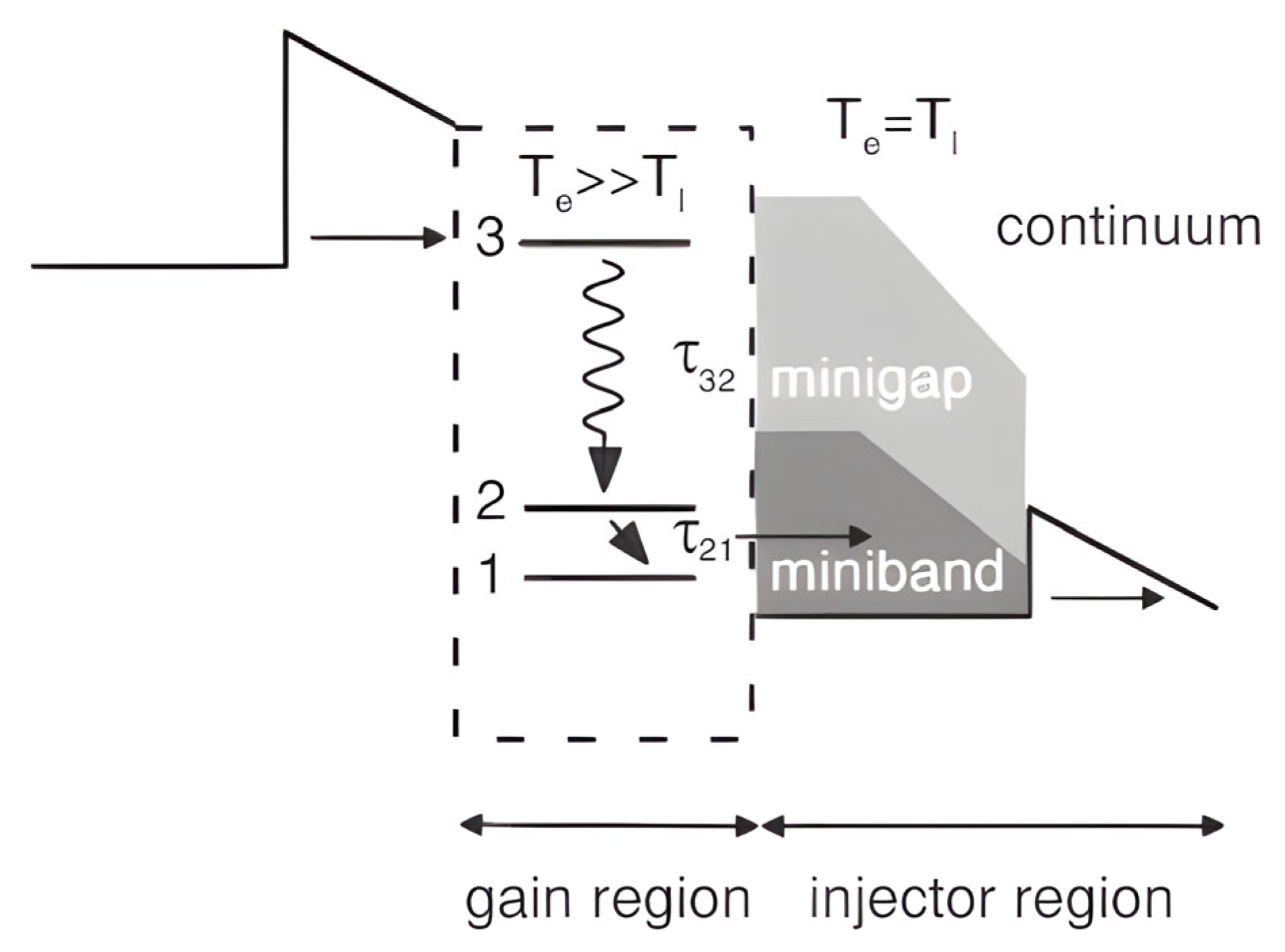
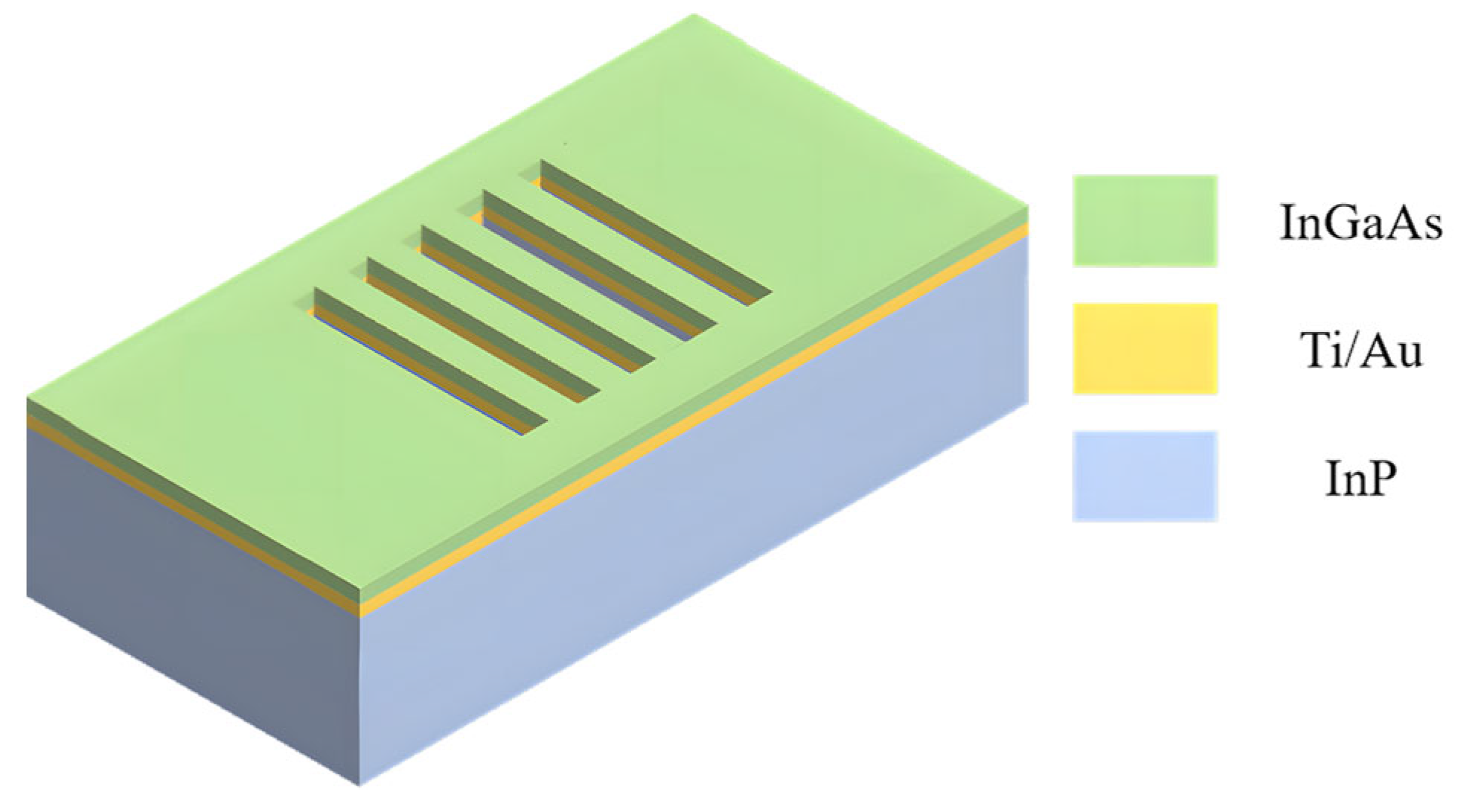
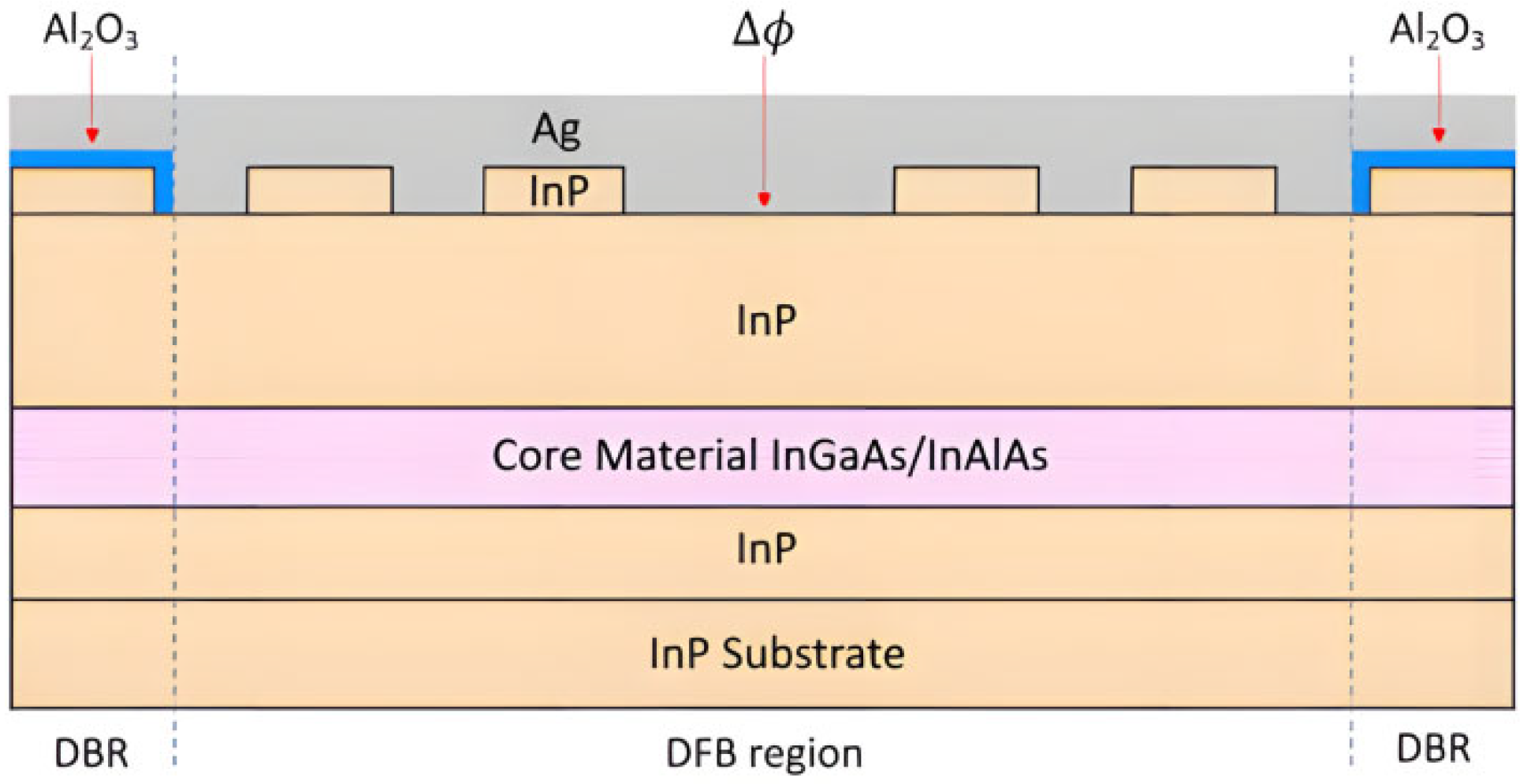

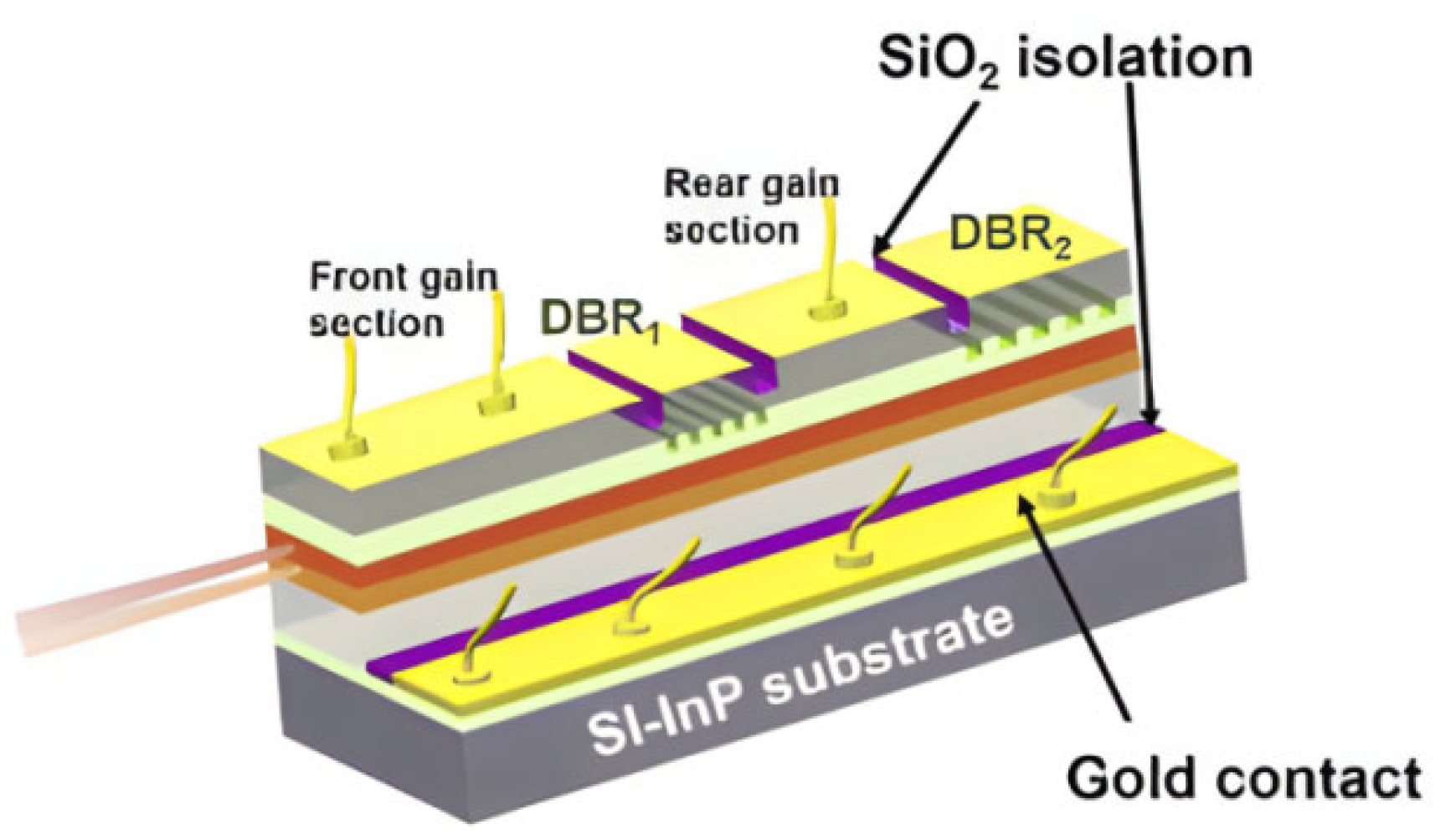


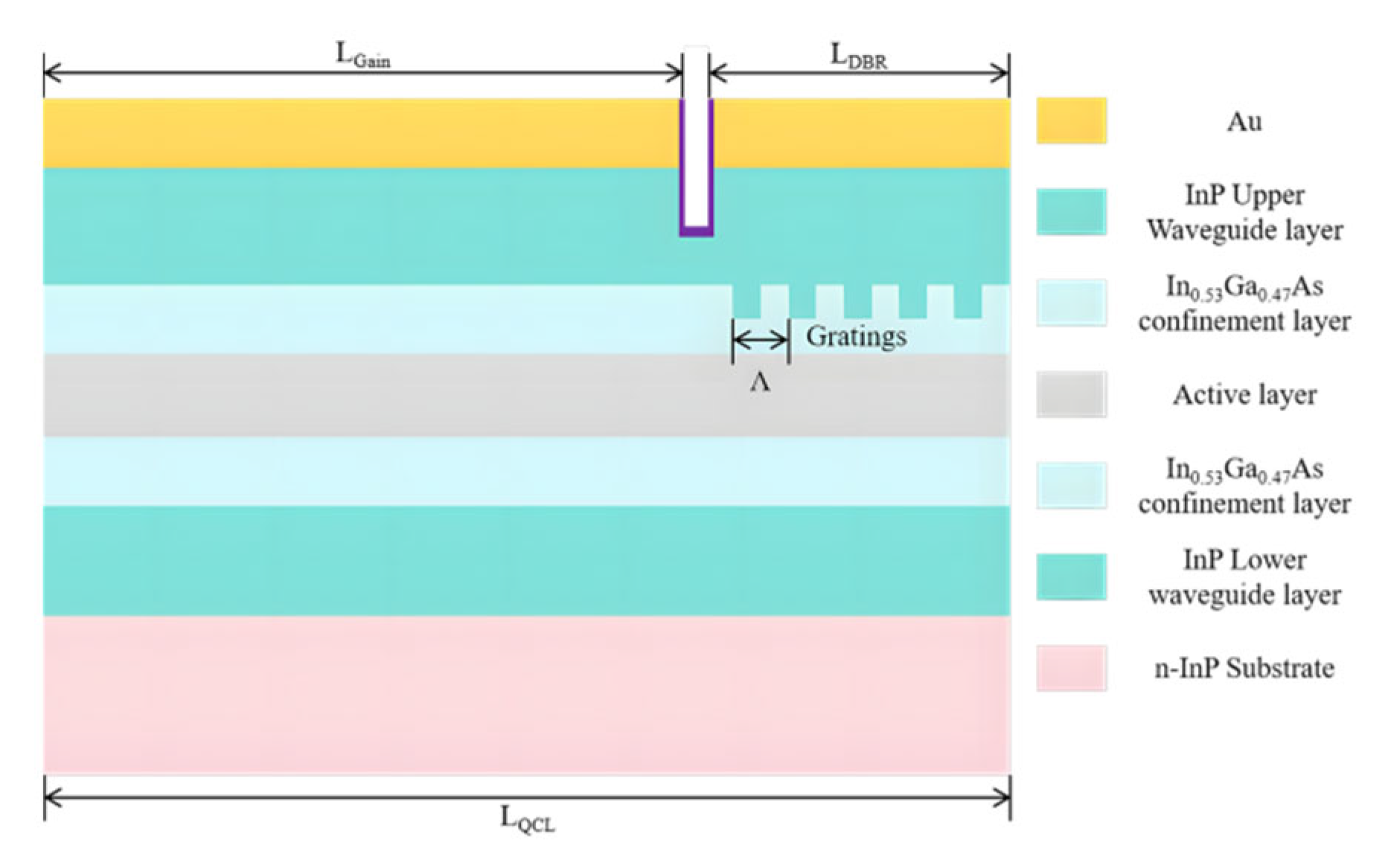
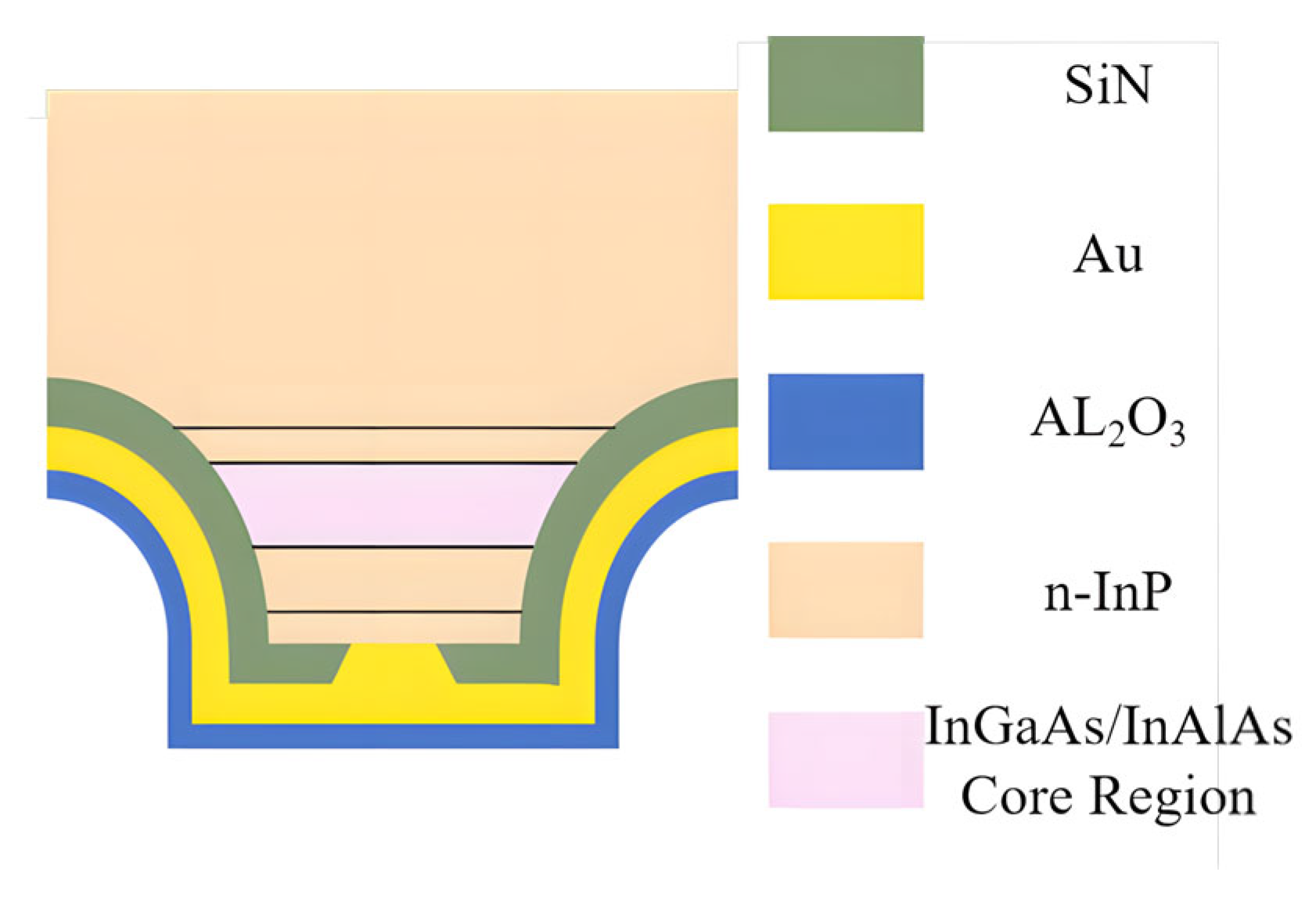

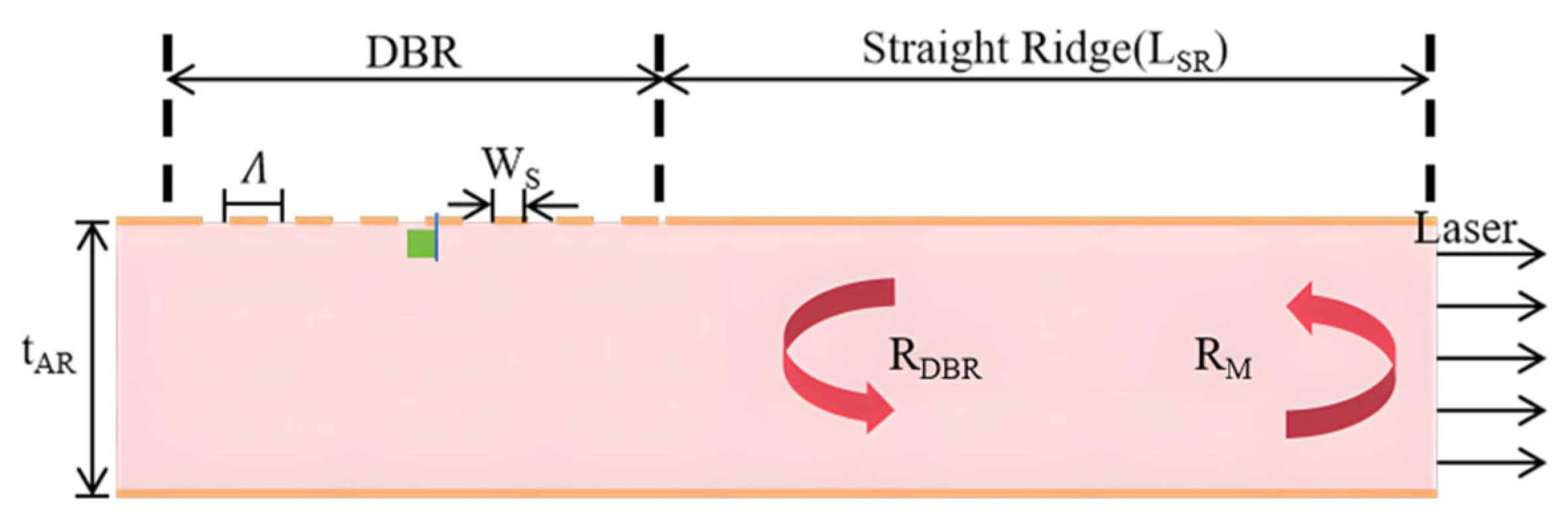
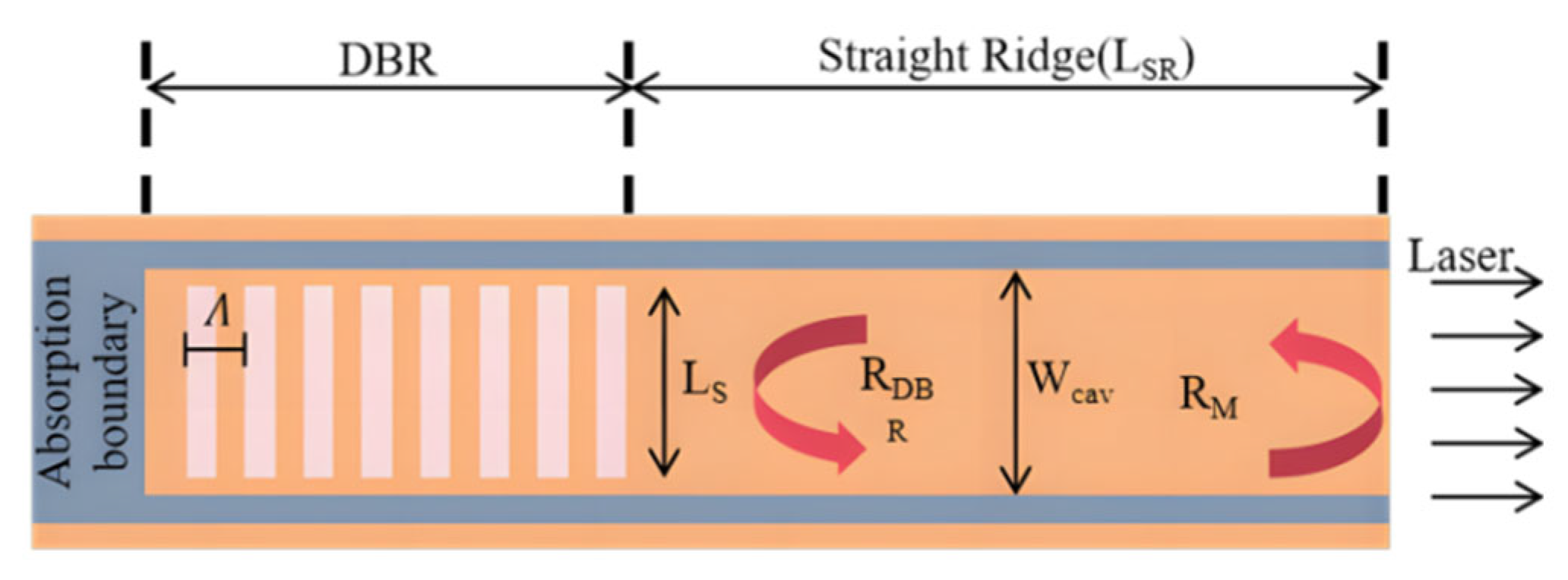

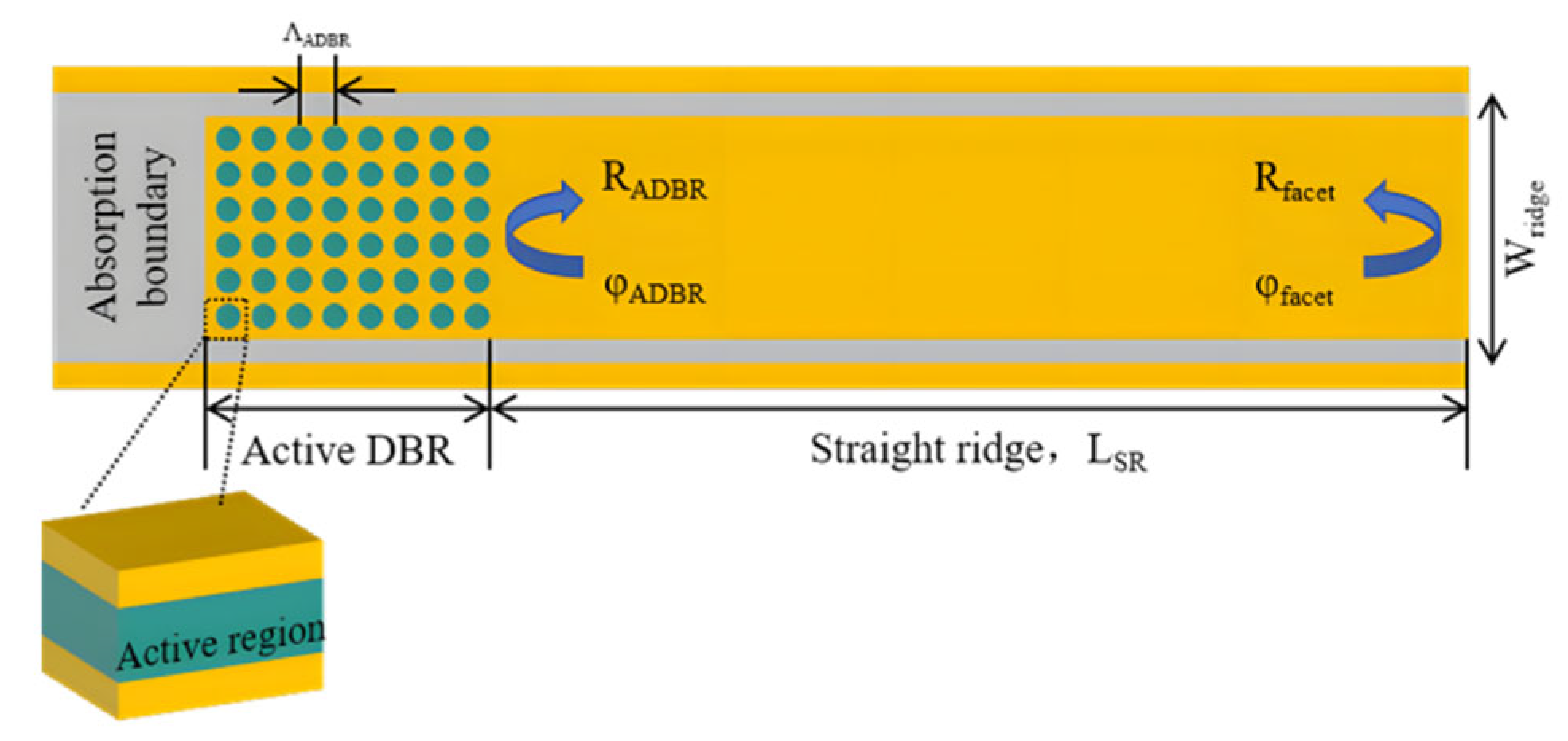


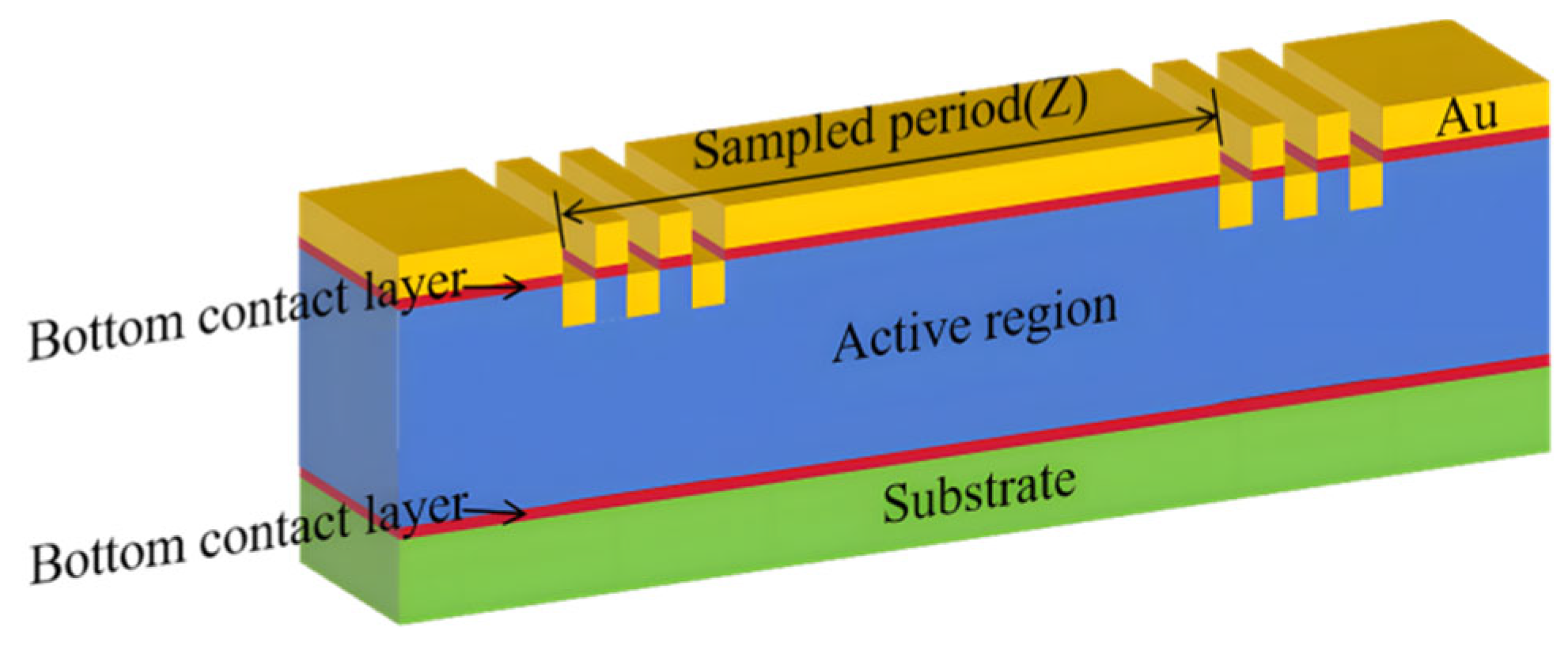
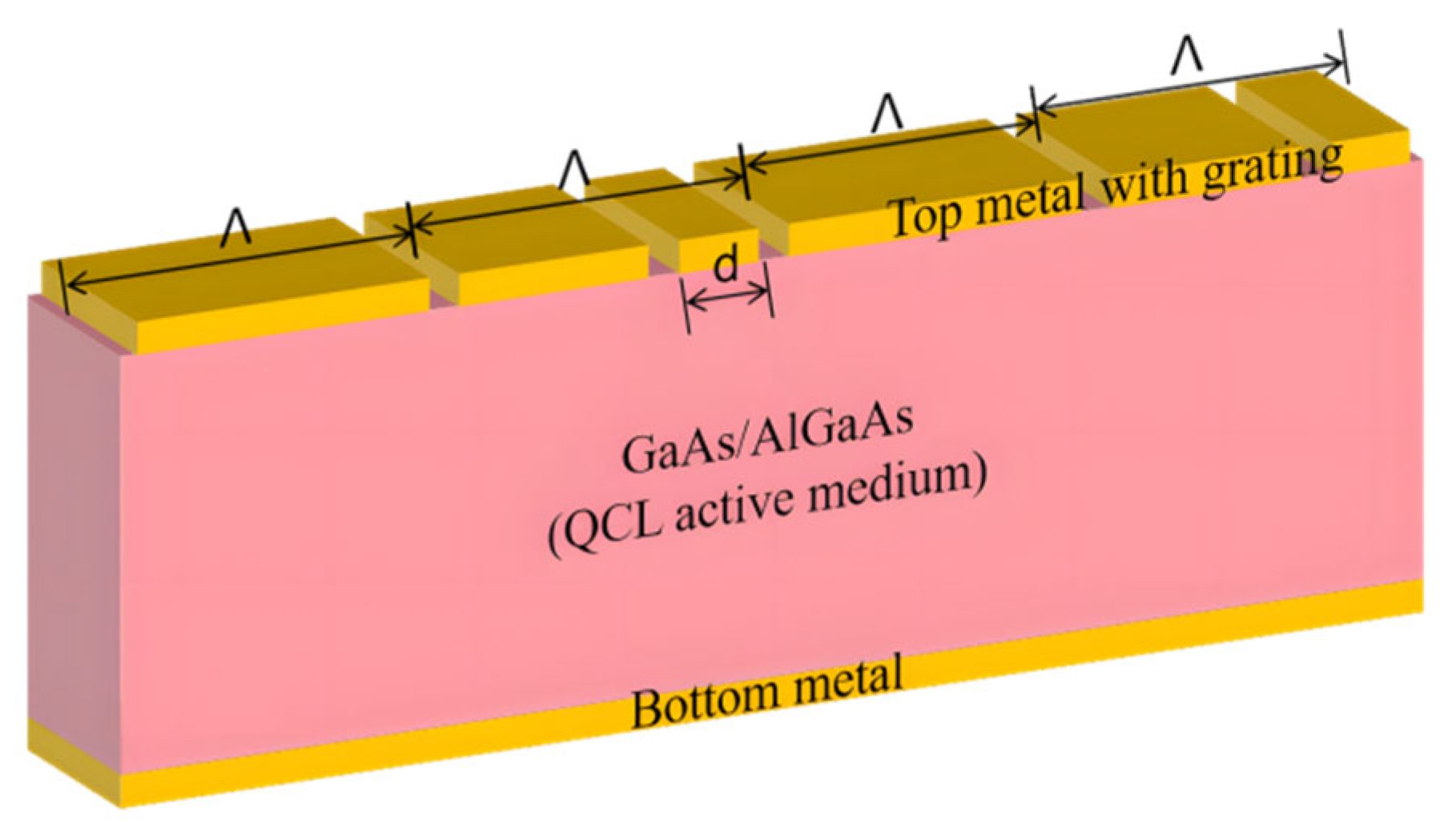
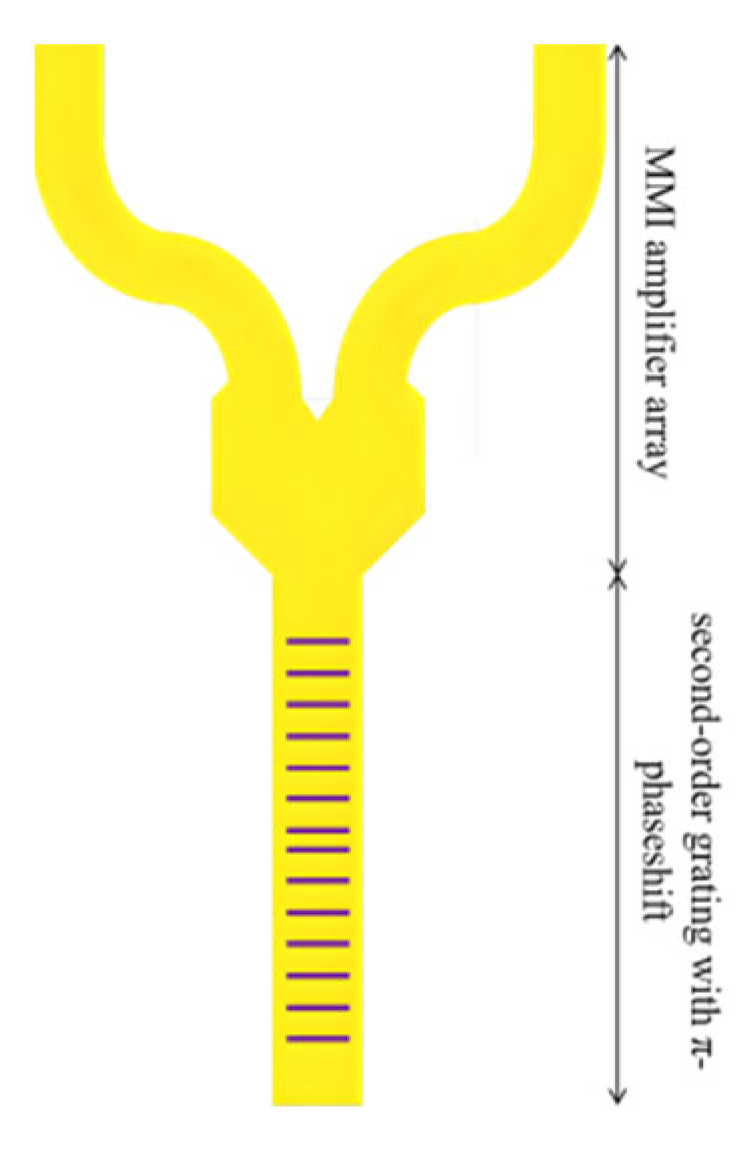

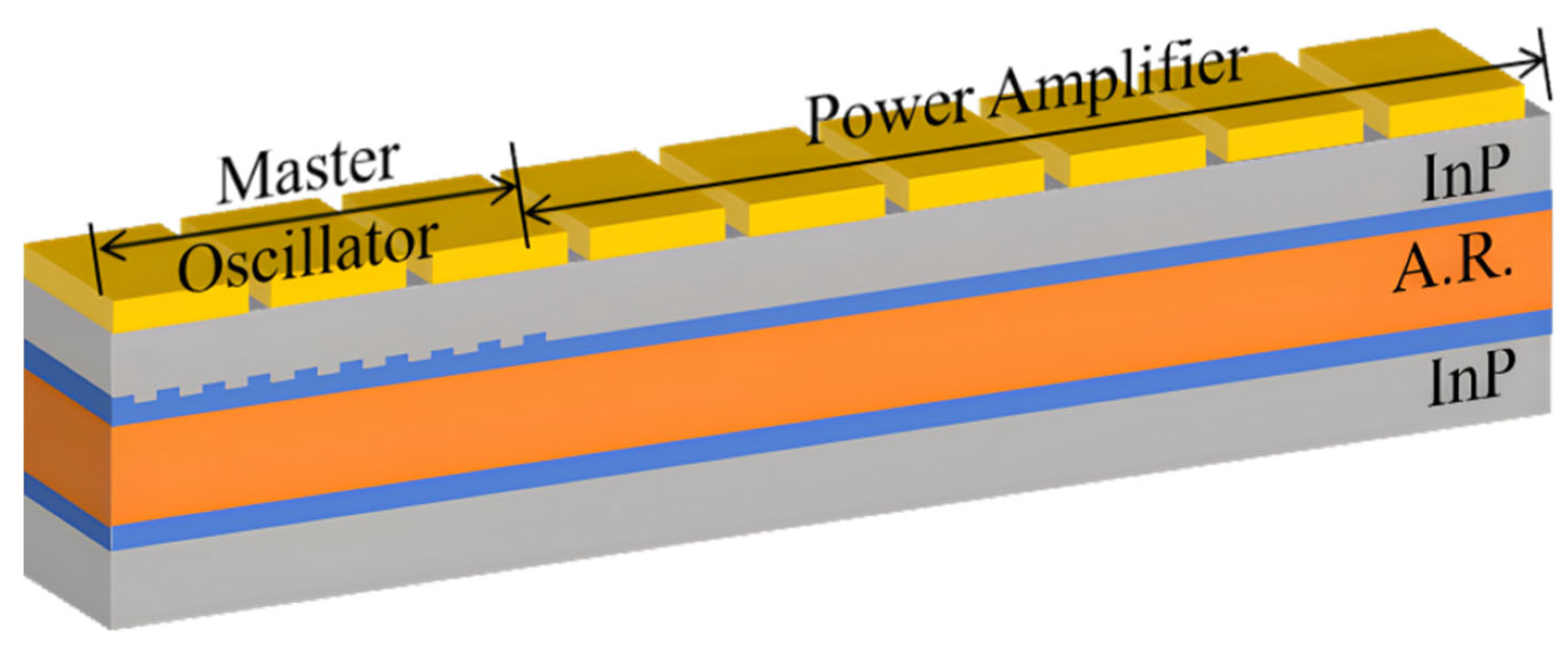
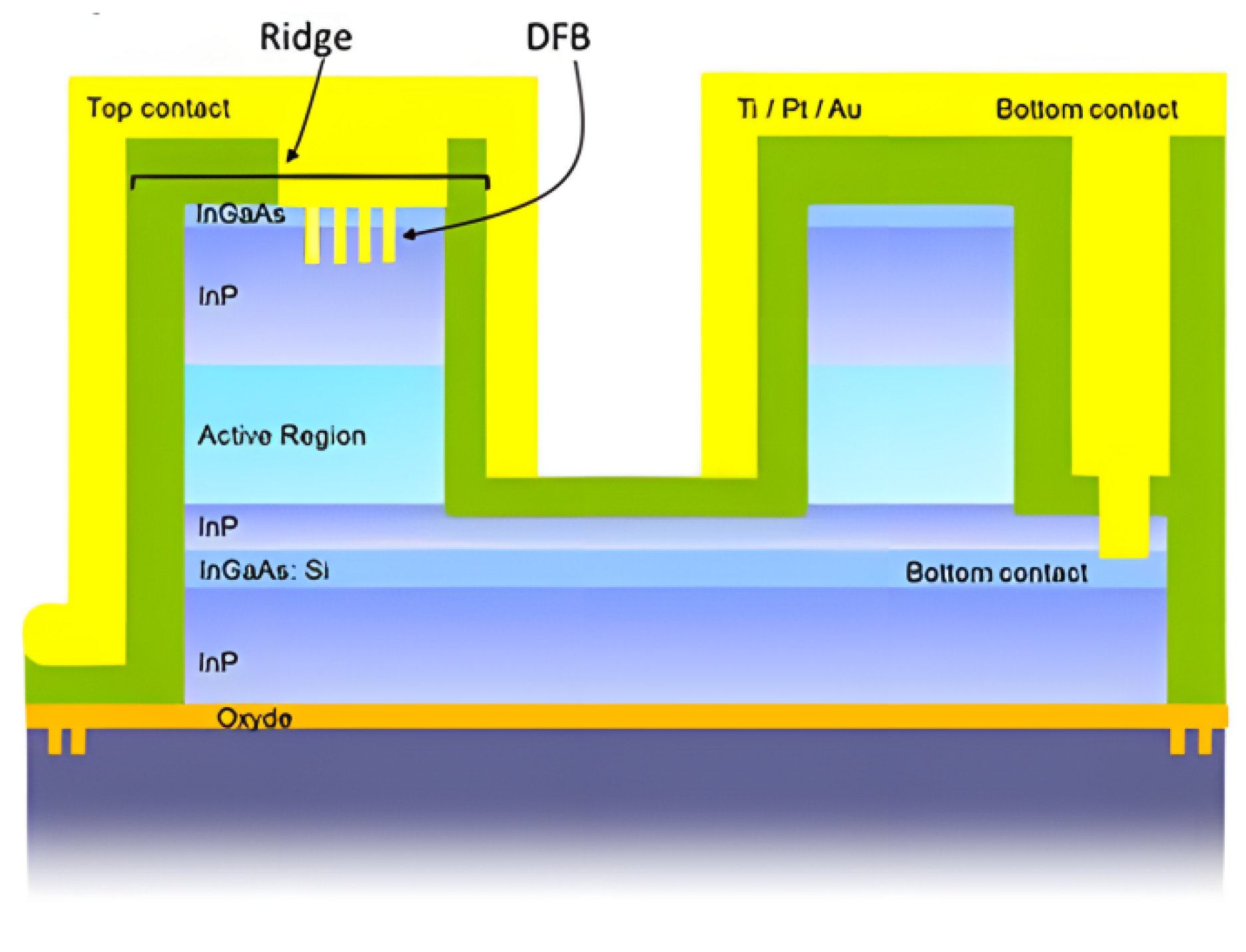
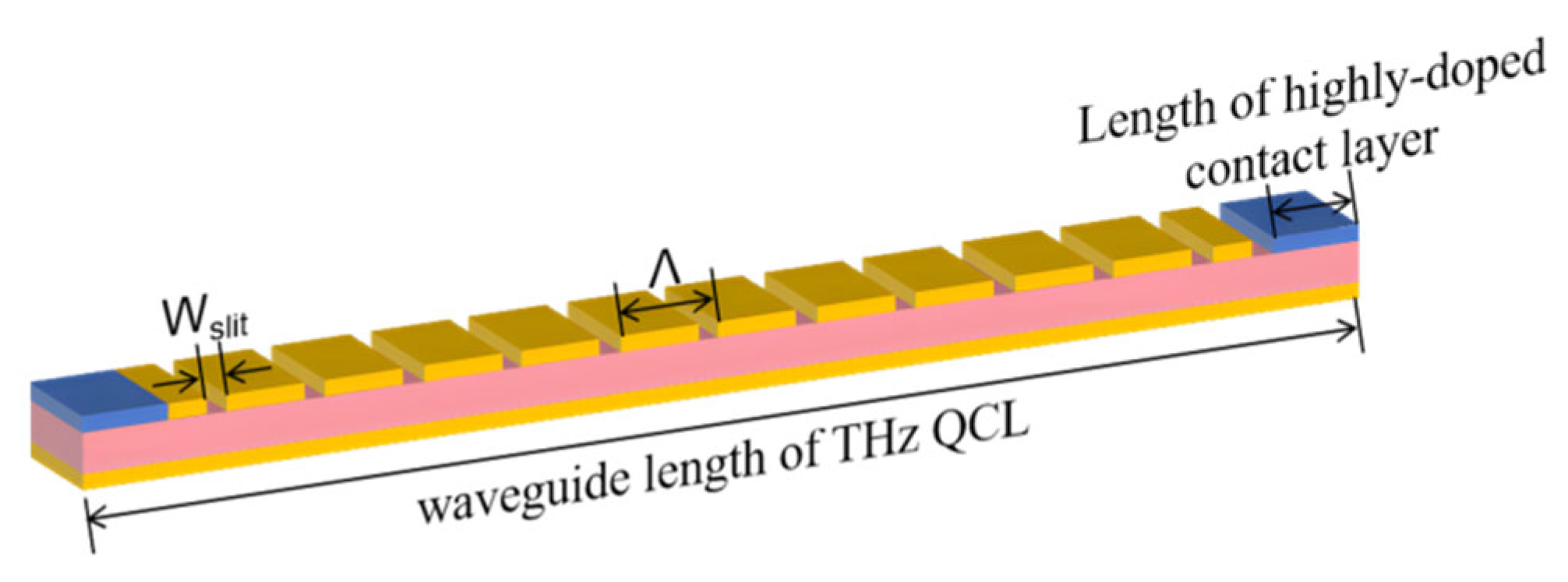
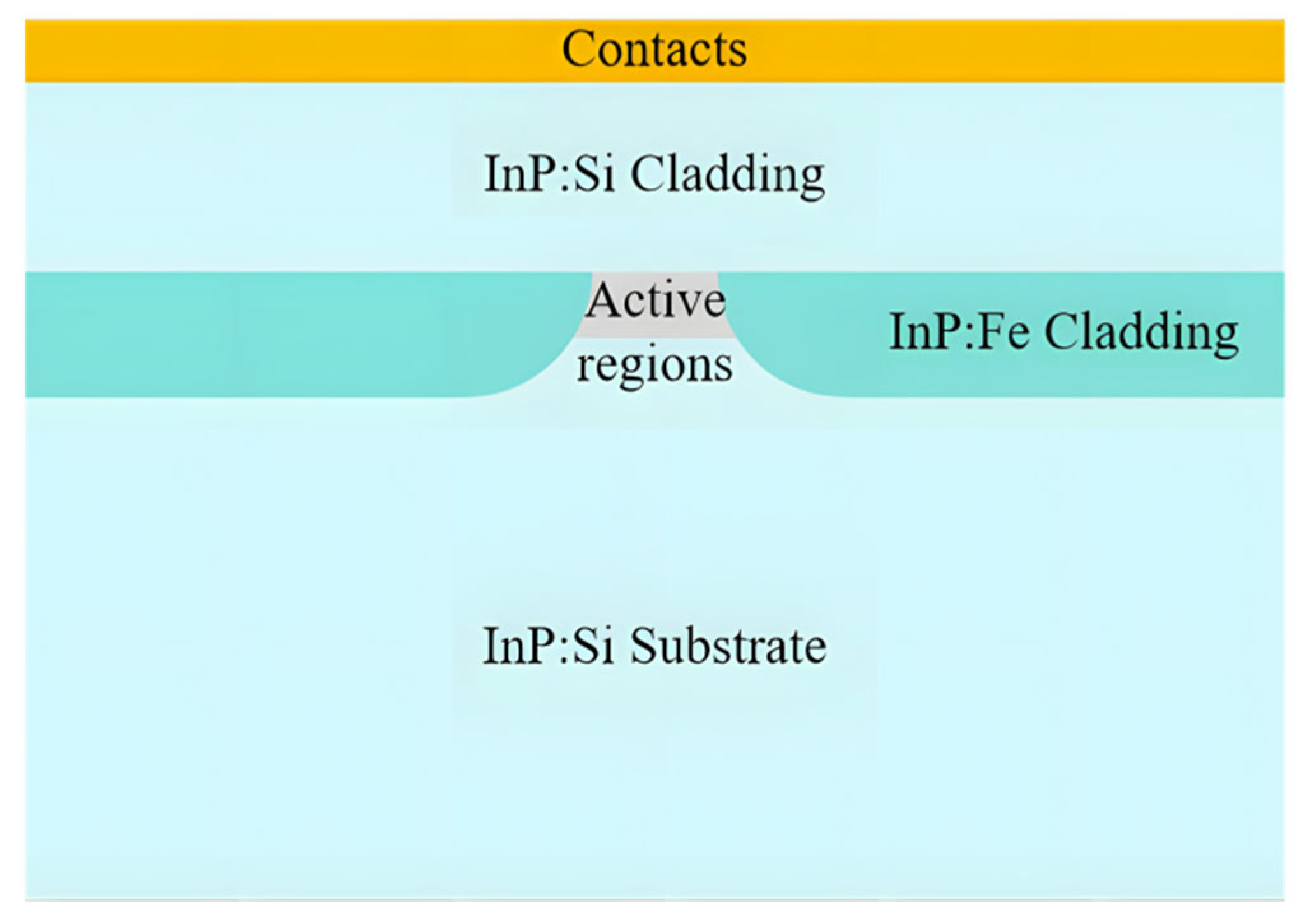

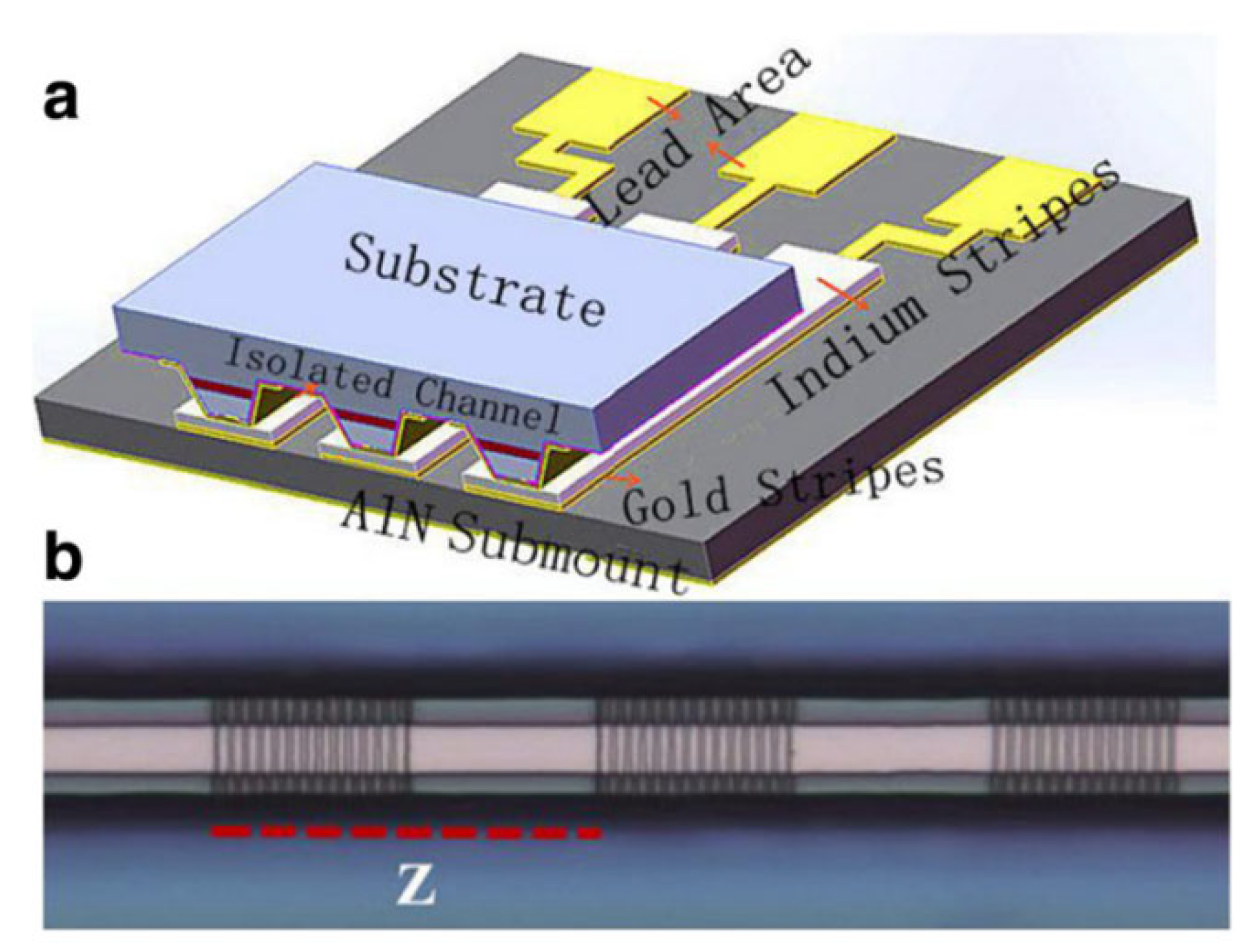
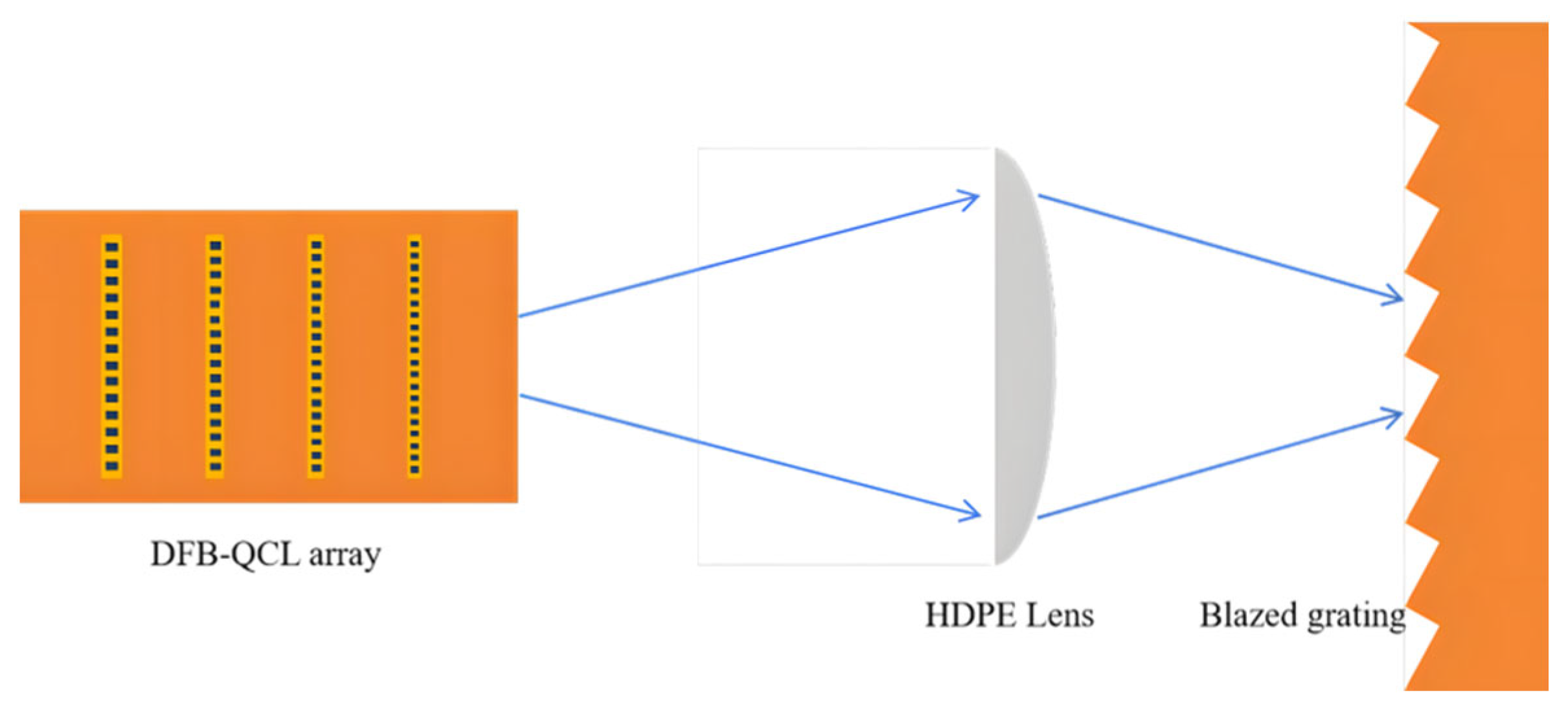
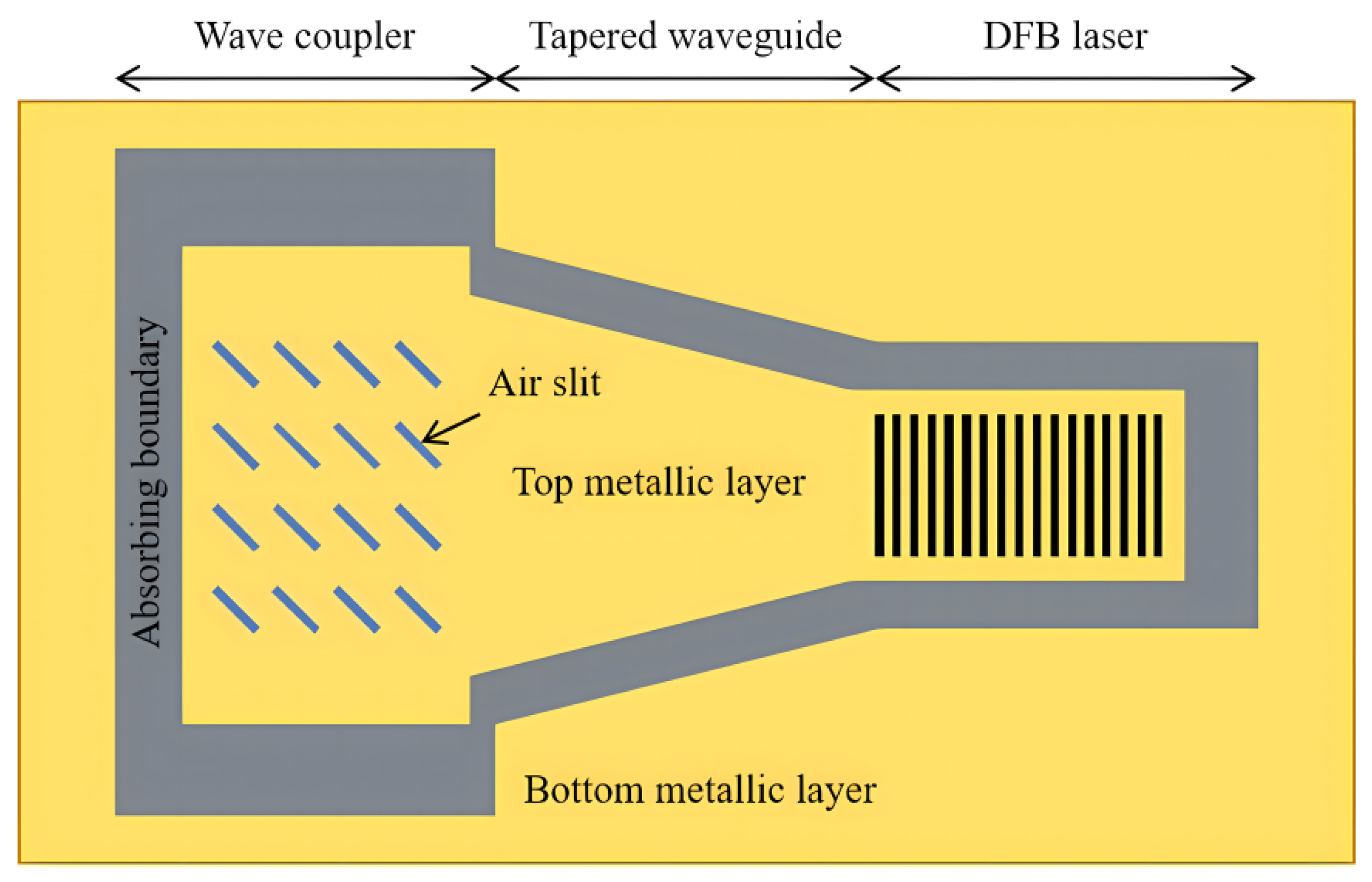

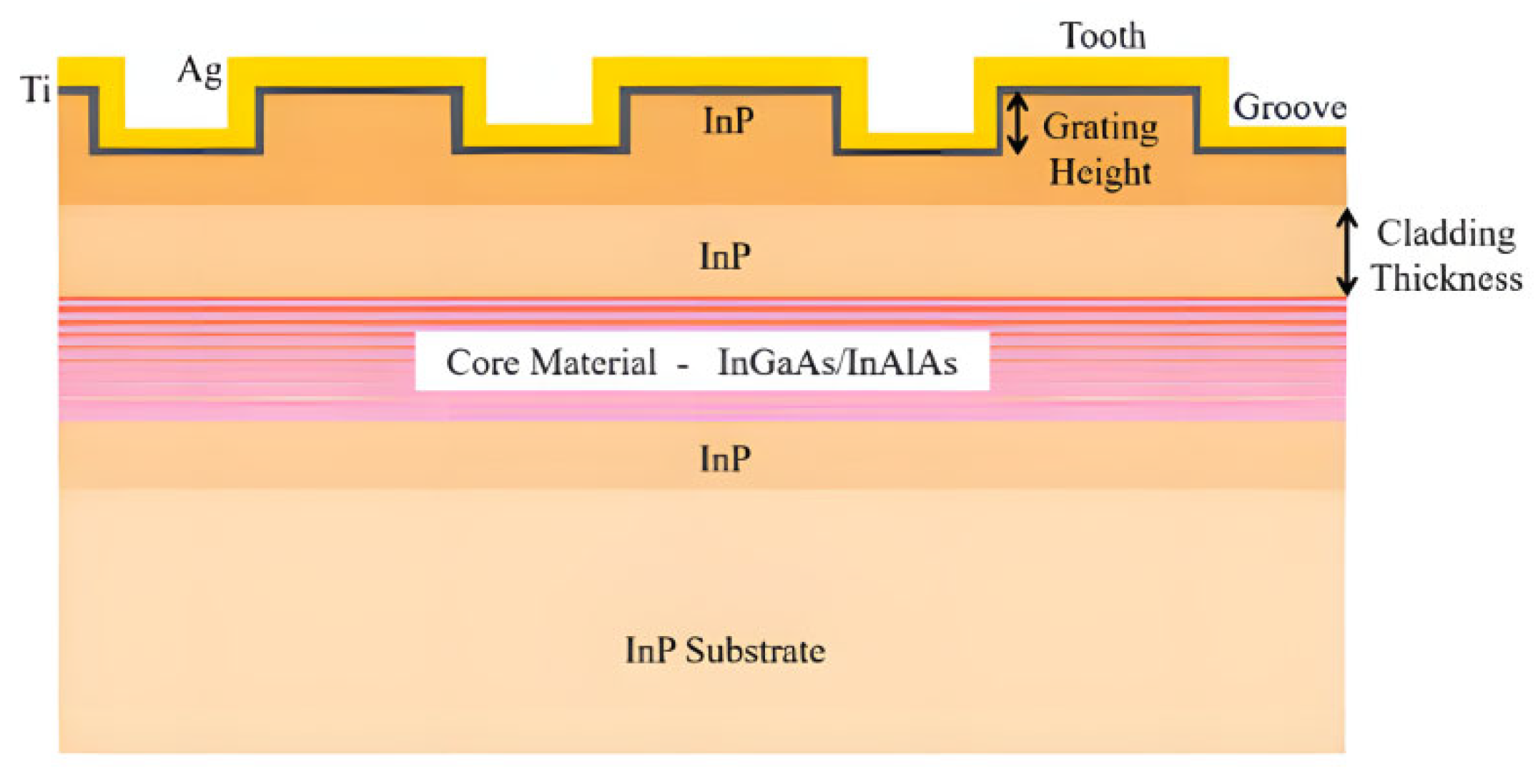
| Parameter | Mid-IR DFB | Mid-IR DBR | THz DFB | THz DBR | Refs. |
|---|---|---|---|---|---|
| Wavelength | 3.36–10.56 μm | 3.5–8.4 μm | 2.58–4.7 THz | 2.7–5.1 THz | [14,15,16,17,18] |
| Power | 2.4 W (CW) | >1 W(CW) | 185 mW (p) | 30 μW (p) | [3,12,13,16] |
| Consumption | 0.25 W (CW) | ≈5 W(sys) | High | ≈2 W(pk) | [19,20,21] |
| SMSR | >30 dB | >25 dB | 23 dB | >25 dB | [16,17,18,22] |
| Tuning | 230 cm−1 | ±0.5 nm 95 cm−1 | <1 cm−1 | ±2 GHz | [7,12,17,19] |
| Temperature | 408 K (CW) | 375 K (CW) | 473 K (p) | 170 K | [10,13,16,21] |
| Feature | DFB-QCL | DBR-QCL |
|---|---|---|
| Mode Control | (SMSR > 30 dB) [16,22] | [11] |
| Tuning Range | SG:230 cm−1 [7] Dual-grating: <100 ns switch [23] | SG-DBR: 156 cm−1 [9] Dual-DBR: Δλ = 0.8 μm [24] |
| Thermal/Beam | SM-PEPC: 185 mW @THz [13,25] Ring cavity: <3° div [26] | Ge-on-SOI: 0.009 nm/°C drift [19] Asymmetric gratings: 14.6° × 12.3° [27] |
| Fabrication | Deep UV: 200 mm wafer [28] ML design: −90% time [29,30,31] | IBE: Ra = 8.7 nm [32] Hybrid: 91.4% yield [33] |
| Beam Control | Ring gratings compress divergence to <3° [26,34] | Asymmetric gratings achieve 14.6° × 12.3° divergence [27] |
| Key Applications | Gas sensing: <10 kHz linewidth [5] FSO: 1.2 GHz BW [35] | Multi-gas: ppb-level CH4/N2O [4] Dual-λ: <15 μs switch [24] |
| Metric | State-of-the-Art | Key Technology | Reference |
|---|---|---|---|
| Output Power | 14.5 W (pulsed) | Cascade active region design | [17] |
| Tuning Range | 880 GHz | Digitally concatenated gratings | [37] |
| Max. Temperature | 473 K (200 °C) | Strain-compensated InGaAs/InAlAs | [38] |
| Spectral Linewidth | 78 kHz | External cavity feedback | [5] |
| Manufacturing Cost | $0.2/mW | 200 mm CMOS-compatible process | [28] |
| Ref. | Year | Core Innovation | Test Cond. | λ | Pout | SMSR | Jth (kA/cm2) | T0 (K) | Key Perf. |
| [32] | 2020 | Low-loss IBE | Pulse@80 K, 1.8 kA/cm2 | 85.7 THz | 128 mW | 26.3 dB | 1.75 | 92 | Scatt. loss↓34% |
| [40] | 2016 | Thin WG low-pwr | CW@25 °C, 750 mA | 5.6 μm | 83.5 mW | 32.8 dB | 1.55 | 176 | Pwr < 0.87 W |
| [33] | 2021 | DFB-DBR hybrid | Pulse@25 °C, 2.8 A | 4.6 μm | 2.35 W | 33.5 dB | 1.85 | 141 | Yield ↑40% |
| [40] | 2016 | Si-bonded thermal | CW@25–100 °C, 850 mA | 7.4 μm | 62 mW | 34.2 dB | 1.70 | 152 | Tune ± 0.3 cm−1/°C |
| [9] | 2012 | SG-DBR wide | CW@25 °C, 850 mA | 4.62–4.91 μm | 57.6 mW | >36 dB | 1.80 | 145 | Tune > 150 cm−1 |
| [4] | 2015 | SG-DBR multi-gas | CW@25 °C, 800 mA | 7.64–8.62 μm | 61.2 mW | >35 dB | 1.75 | 150 | ppb CH4/N2O/H2O |
| [24] | 2021 | Dual-DBR switch | Pulse@25 °C, 1.8 A | 8.3/9.1 μm | 85/78 mW | >31 dB | 1.75 | 149 | Δλ = 0.8 μm, <15 μs |
| [12] | 2023 | Post-proc λ corr | Pulse@−10 °C, 1.5 kA/cm2 | 63.8 THz | 15.2 mW | 28.4 dB | 1.65 | 105 | Precision 0.11 cm−1 |
| [19] | 2019 | Ge-on-SOI | CW@25–85 °C, 1.1 A | 4.8 μm | 105 mW | 33.6 dB | 1.60 | 158 | Drift 0.009 nm/°C |
| [16] | 2024 | 102 °C SM | CW@102 °C, 1.25 A | 8.4 μm | 1.18 W | 35.8 dB | 1.95 | 182 | Drift 0.0078 nm/°C |
| [27] | 2020 | Non-rect grating | Pulse@25 °C, 2.5 A | 4.6 μm | 2.17 W | 31.7 dB | 1.90 | 132 | Div. < 15° |
| [42] | 2021 | Detune coupler | CW@25 °C, 980 mA | 8.3 μm | 81.7 mW | 38.3 dB | 1.70 | 167 | M2 < 1.48 |
| [11] | 2023 | 3.6 mm gain | Pulse@80 K, 115 A/cm2 | 111 THz | 8.7 mW | 26.1 dB | 0.112 | 68 | Linewidth 4.18 MHz |
| [41] | 2022 | DBR-VCSEL | Pulse@25 °C, 1.82 kA/cm2 | 4.3 μm | 12.3 mW | 28.5 dB | 1.79 | 118 | Div. 8.4° |
| [43] | 2022 | THz pwr-decouple | Pulse@80 K, 1.1 kA/cm2 | 85.7 THz | 11.3 mW | 29.3 dB | 1.05 | 75 | Efficiency 32.4% |
| Ref. | Year | Innovation | Test Cond. | λ | Pout | SMSR | Jth (kA/cm2) | T0(K) | Key Perf. |
|---|---|---|---|---|---|---|---|---|---|
| [44] | 2019 | Non-rect grating opt | Pulsed@300 K, 0.8–1.2 A | ~4.6 μm | 850 mW | >30 dB | 1.05 | 185 | Δλ/ΔT = 0.03 nm/K |
| [37] | 2020 | Taper SG + WG | Pulsed@288 K, 100 kHz | ~4.55 μm | 1.2 W | >35 dB | 1.10 | 210 | Div = 4.7°, M2 = 1.8 |
| [48] | 2019 | SG THz mode ctrl | Pulsed@10 K | 3.2 THz | 18 mW | >25 dB | 0.14 | - | Δν/ΔT = 0.02 cm−1/K |
| [45] | 2022 | Graded SG comp | CW@50 K | 5.1 THz | 3.2 mW | >30 dB | 0.15 | - | Stable@10–100 K |
| [7] | 2012 | Dual-sect elec tune | CW@300 K | 4.6 μm | >50 mW | >30 dB | 0.93 | 182 | Tune: 5.5 cm−1 |
| [51] | 2025 | Broken-per grat eff | Pulsed@78 K | 3.1 THz | 45 mW | >28 dB | 0.22 | - | Rad Eff ↑50% |
| [50] | 2024 | MMI beam shape | CW@80 K | 3.6 THz | 8.5 mW | 26 dB | 0.25 | - | M2 = 1.6 |
| [49] | 2018 | Hybrid-order Bragg | Pulsed@80 K | 3.8 THz | 52 mW | 27 dB | 0.23 | - | Surf Eff↑35% |
| [58] | 2022 | 2D metal grat steer | Pulsed@78 K,1μs | 3.5 THz | 120 mW | 28 dB | 0.18 | - | Scan ± 30° |
| [26] | 2023 | Ring cavity SE | Pulsed@300 K | ~3.8 μm | 65 mW | >30 dB | 0.75 | - | Div < 3° |
| [46] | 2023 | Grat anti-hop | CW@300 K, 1.5 Ith | ~4.8 μm | 210 mW | 25 dB | 0.95 | 188 | ΔP < 5% |
| [52] | 2018 | AR coat high-T | CW@90 °C | 4.6 μm | 170 mW | 26 dB | 0.65 | 198 | SMSR@90 °C |
| [39] | 2022 | Strain-comp AR | CW@20–90 °C | 6.12 μm | 170 mW | 26 dB | 0.98 | 210 | ΔT = 70 °C |
| [5] | 2022 | Subλ HC grating | CW@298 K | ~5.4 μm | 108 mW | 32 dB | 0.85 | 195 | Δν = 10 kHz |
| [28] | 2020 | 200 mm CMOS | CW@300 K | 4.6 μm | 150 mW | >25 dB | 1.15 | - | Yield 85% |
| [29] | 2021 | ML resonance pred | Pulsed@80 K | 3.5 THz | 25 mW | >25 dB | 0.20 | - | Design cycle ↓90% |
| [23] | 2023 | Mono dual-λ | CW@300 K | 4.65/4.82 μm | 25/22 mW | >30 dB | 0.92 | - | Switch < 100 ns |
| [56] | 2018 | Dual-sect DFB gas | Pulsed@300 K | 5.18/5.26 μm | >15 mW × 2 | >28 dB | 0.87 | - | Δλ stab |
| [55] | 2016 | Dual-grat Y-WG | CW@298 K | 7.73/7.85 μm | >12 mW × 2 | >30 dB | 0.82 | - | XT < −35 dB |
| [57] | 2015 | SG array | CW@288 K | 4.55 μm | 1.5 W (16 ch) | >25 dB | 1.05 | - | Δλ < 0.02 μm |
| [47] | 2024 | PL array λ/4 grat | Pulsed@78 K | 3.8 THz | 185 mW (8 ch) | 28 dB | 0.16 | - | φ err < λ/10 |
| [38] | 2021 | WBC array | Pulsed@78 K | 3.9–4.1 THz | 110 mW (4 ch) | >25 dB | 0.19 | - | Tune 0.2 THz |
| [35] | 2025 | FS comm grating | CW@300 K | 4.7 μm | 80 mW | >25 dB | 0.89 | 180 | BW 1.2 GHz |
Disclaimer/Publisher’s Note: The statements, opinions and data contained in all publications are solely those of the individual author(s) and contributor(s) and not of MDPI and/or the editor(s). MDPI and/or the editor(s) disclaim responsibility for any injury to people or property resulting from any ideas, methods, instructions or products referred to in the content. |
© 2025 by the authors. Licensee MDPI, Basel, Switzerland. This article is an open access article distributed under the terms and conditions of the Creative Commons Attribution (CC BY) license (https://creativecommons.org/licenses/by/4.0/).
Share and Cite
Zheng, J.; Xu, D.; Wu, Q.; Zhang, C.; Lin, Y.; Yuan, M.; Qu, Y. Research Progress of Single-Mode Quantum Cascade Lasers. Coatings 2025, 15, 950. https://doi.org/10.3390/coatings15080950
Zheng J, Xu D, Wu Q, Zhang C, Lin Y, Yuan M, Qu Y. Research Progress of Single-Mode Quantum Cascade Lasers. Coatings. 2025; 15(8):950. https://doi.org/10.3390/coatings15080950
Chicago/Turabian StyleZheng, Jiewei, Dongxin Xu, Qi Wu, Chi Zhang, Yishui Lin, Mingkun Yuan, and Yi Qu. 2025. "Research Progress of Single-Mode Quantum Cascade Lasers" Coatings 15, no. 8: 950. https://doi.org/10.3390/coatings15080950
APA StyleZheng, J., Xu, D., Wu, Q., Zhang, C., Lin, Y., Yuan, M., & Qu, Y. (2025). Research Progress of Single-Mode Quantum Cascade Lasers. Coatings, 15(8), 950. https://doi.org/10.3390/coatings15080950







